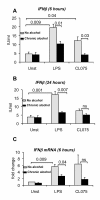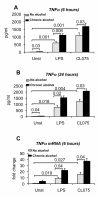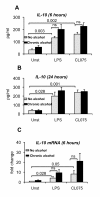Inhibition of TLR8- and TLR4-induced Type I IFN induction by alcohol is different from its effects on inflammatory cytokine production in monocytes
- PMID: 21962237
- PMCID: PMC3203086
- DOI: 10.1186/1471-2172-12-55
Inhibition of TLR8- and TLR4-induced Type I IFN induction by alcohol is different from its effects on inflammatory cytokine production in monocytes
Abstract
Background: Prolonged alcohol consumption is a significant co-factor in the progression of chronic viral infections including hepatitis C and HIV, which are both single-stranded RNA viruses. Toll like receptor 8 (TLR8), a pattern recognition receptor expressed in monocytes, senses viral single stranded RNA as a danger signal and leads to the induction of Type I interferon (IFN) as well as the pro-inflammatory cytokine, tumor necrosis factor alpha (TNF alpha). Lipopolysaccharide (LPS), a Toll like receptor 4 (TLR4) ligand, was shown to affect inflammatory cell activation after alcohol consumption and in HIV and HCV infections. Here we hypothesized that alcohol exposure modulates TLR8- and TLR4-ligand-induced monocyte activation and affects both type I IFN and inflammatory cytokine induction.
Results: The TLR8 ligand, CL075, as well as the TLR4 ligand, LPS, resulted in a significant induction of TNF alpha both at the mRNA and protein levels in human monocytes. We found that both acute and prolonged alcohol treatment resulted in inhibition of type I IFN induction by either TLR8 or TLR4 ligands in human monocytes at the protein and mRNA levels. In contrast to Type I IFN production, the effects of acute and prolonged alcohol were different on inflammatory cytokine activation after TLR8 or TLR4 ligand stimulation. Acute alcohol inhibited TLR8- or TLR4-induced TNF alpha protein and mRNA induction while it augmented IL-10 production in monocytes. In contrast, prolonged alcohol treatment augmented TNF alpha without affecting IL-10 production significantly in response to either TLR8 or TLR4 ligand stimulation.
Conclusions: These novel results suggest first, that alcohol has a profound inhibitory effect on Type I IFN induction regardless of intracellular (TLR8) or cell surface-derived (TLR4) danger signals. Second, both acute and prolonged alcohol exposure can inhibit antiviral Type I IFN pathway activation. Third, the opposite effects of acute (inhibitory) and prolonged alcohol (augmentation) treatment on pro-inflammatory cytokine activation extend to TLR8-induced signals beyond the previously shown TLR4/LPS pathway.
Figures






Similar articles
-
Epstein-Barr virus lytic infection promotes activation of Toll-like receptor 8 innate immune response in systemic sclerosis monocytes.Arthritis Res Ther. 2017 Feb 28;19(1):39. doi: 10.1186/s13075-017-1237-9. Arthritis Res Ther. 2017. PMID: 28245863 Free PMC article.
-
Chemokine, cytokine and type I interferon production induced by Toll-like receptor activation in common variable immune deficiency.Clin Immunol. 2016 Aug;169:121-127. doi: 10.1016/j.clim.2016.07.001. Epub 2016 Jul 5. Clin Immunol. 2016. PMID: 27392462
-
TLR activation pathways in HIV-1-exposed seronegative individuals.J Immunol. 2010 Mar 1;184(5):2710-7. doi: 10.4049/jimmunol.0902463. Epub 2010 Feb 1. J Immunol. 2010. PMID: 20124101
-
Effect of ethanol on inflammatory responses. Implications for pancreatitis.Pancreatology. 2007;7(2-3):115-23. doi: 10.1159/000104236. Epub 2007 Jun 21. Pancreatology. 2007. PMID: 17592223 Free PMC article. Review.
-
Role of toll-like receptor 7/8 pathways in regulation of interferon response and inflammatory mediators during SARS-CoV2 infection and potential therapeutic options.Biomed Pharmacother. 2021 Sep;141:111794. doi: 10.1016/j.biopha.2021.111794. Epub 2021 Jun 10. Biomed Pharmacother. 2021. PMID: 34153851 Free PMC article. Review.
Cited by
-
Transcriptional and Epigenetic Regulation of Monocyte and Macrophage Dysfunction by Chronic Alcohol Consumption.Front Immunol. 2022 Jun 29;13:911951. doi: 10.3389/fimmu.2022.911951. eCollection 2022. Front Immunol. 2022. PMID: 35844518 Free PMC article. Review.
-
Ethanol: striking the cardiovascular system by harming the gut microbiota.Am J Physiol Heart Circ Physiol. 2021 Aug 1;321(2):H275-H291. doi: 10.1152/ajpheart.00225.2021. Epub 2021 Jun 18. Am J Physiol Heart Circ Physiol. 2021. PMID: 34142885 Free PMC article. Review.
-
Comorbid post-traumatic stress disorder in alcohol use disorder: relationships to demography, drinking and neuroimmune profile.BMC Psychiatry. 2017 Aug 29;17(1):312. doi: 10.1186/s12888-017-1479-8. BMC Psychiatry. 2017. PMID: 28851339 Free PMC article.
-
Identification of Key Immune-Related Genes in the Progression of Septic Shock.Front Genet. 2021 Nov 3;12:668527. doi: 10.3389/fgene.2021.668527. eCollection 2021. Front Genet. 2021. PMID: 34804111 Free PMC article.
-
Protection of Gastrointestinal Mucosa from Acute Heavy Alcohol Consumption: The Effect of Berberine and Its Correlation with TLR2, 4/IL1β-TNFα Signaling.PLoS One. 2015 Jul 30;10(7):e0134044. doi: 10.1371/journal.pone.0134044. eCollection 2015. PLoS One. 2015. PMID: 26226164 Free PMC article.
References
Publication types
MeSH terms
Substances
Grants and funding
LinkOut - more resources
Full Text Sources
Other Literature Sources
Molecular Biology Databases
Miscellaneous

